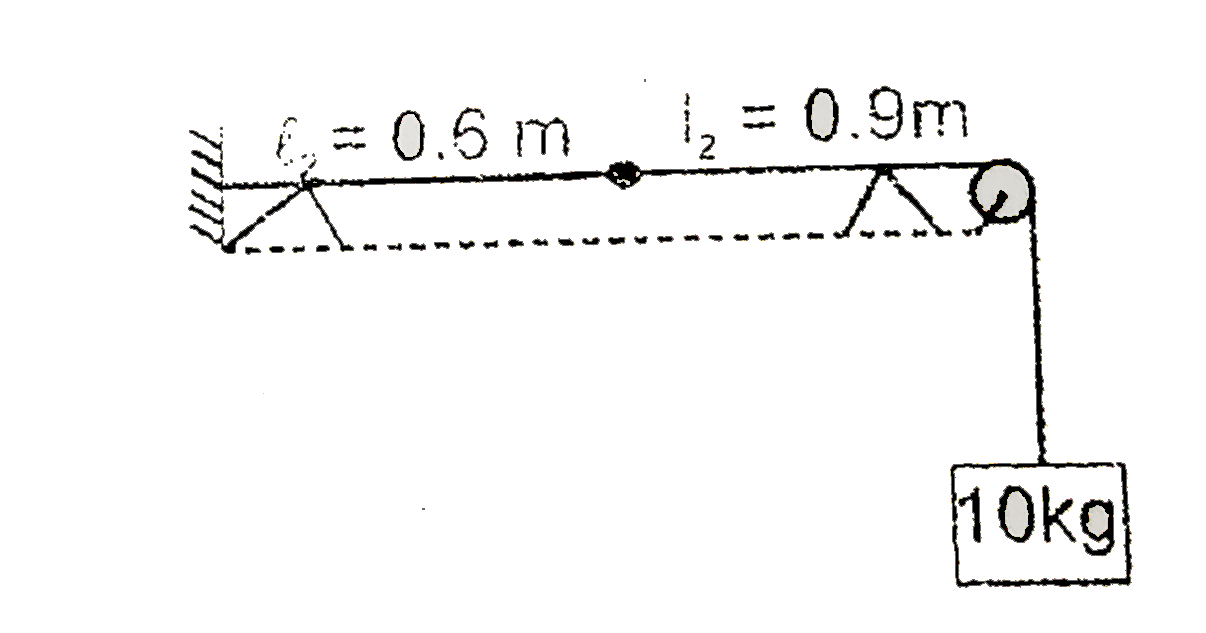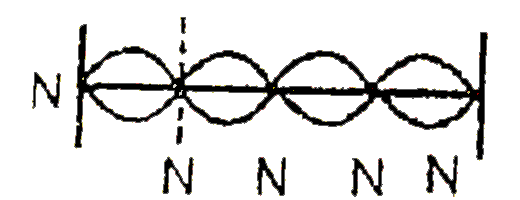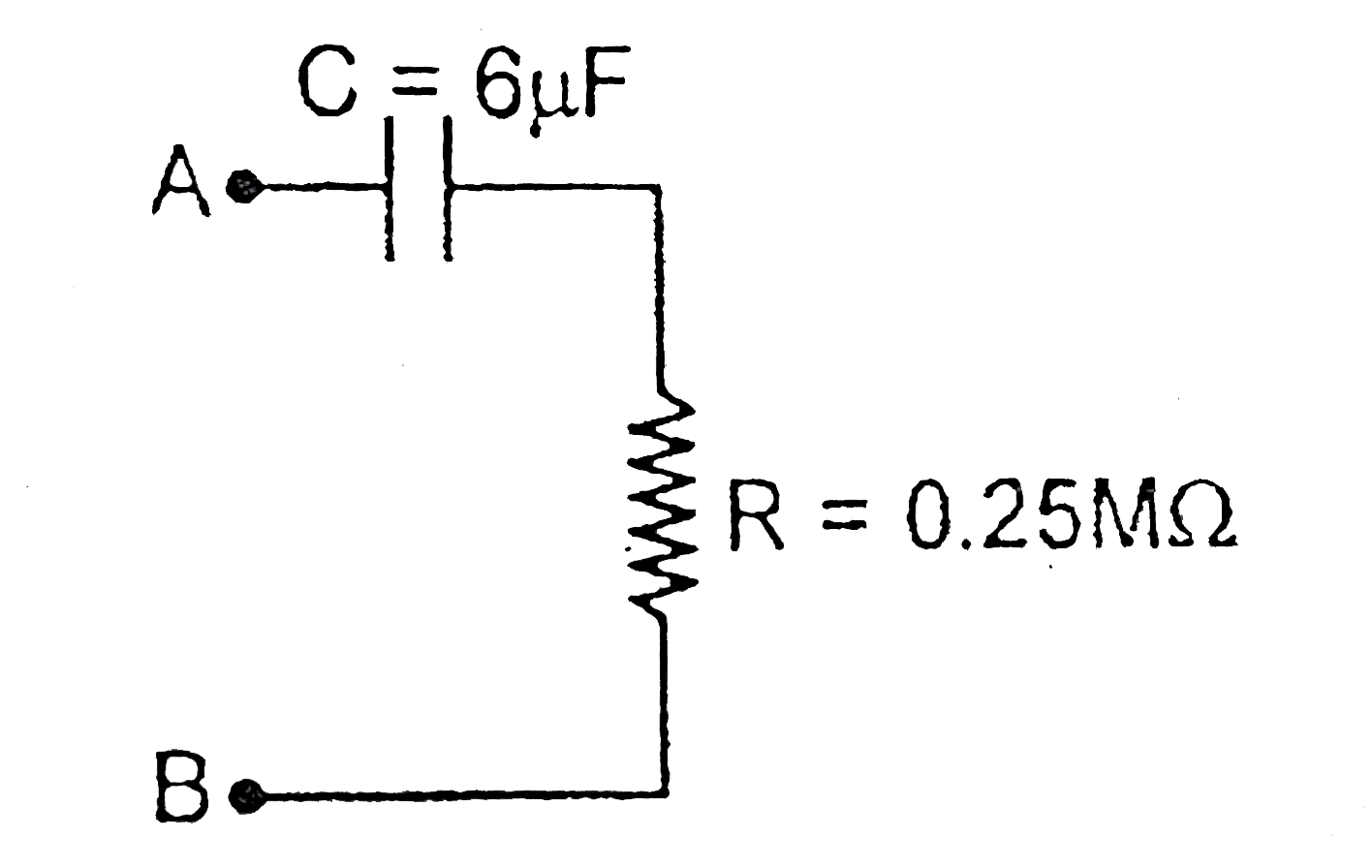An aluminium wire of cross-sectional area (10−6)m2 is joined to a steel wire of the same cross-sectional area. This compound wire is stretched on a sonometer pulled by a weight of 10kg. The total length of the compound wire between the bridges is 1.5m of which the aluminium wire is 0.6m and the rest is steel wire. Transverse vibrations are setup in the wire by using an external source of variable frequency. Find the lowest frequency of excitation for which the standing waves are formed such that the joint in the wire is a node. What is the total number of nodes at this frequency? The density of aluminium is 2.6×(103)kg/m3 and that of steel is 1.04×104kg/m2(g=10m/s2)
The correct Answer is:162 vibration//sec, 3
A=1×10−6m,T=10g=100N
σ1=2.6×103kg/m2,σ2=1.04×104kg/m3
v1=√1001×106×1.04×103=103√26m/sec
V2=√1001×10−6×1.04×104=1032√26
f1=f2
n1×1032×0.6√26=n2×1032×2×0.9√26[n1n2=13]
Lowest frequency =n1v12L1=1×103√26×2×0.6
=10412√26=162vibration/sec.
n1n2=(13)
One side 1 loop and other side 3 loop
 So excluding the two nodes at ends total nodes is 3
So excluding the two nodes at ends total nodes is 3

Topper's Solved these Questions
- TRAVELLING WAVESBook:RESONANCE ENGLISHChapter:TRAVELLING WAVESExercise:Exercise- 3 PART II
Explore 7 Videos
- TRAVELLING WAVESBook:RESONANCE ENGLISHChapter:TRAVELLING WAVESExercise:Exercise- 2 PART IV
Explore 9 Videos
- TEST SERIESBook:RESONANCE ENGLISHChapter:TEST SERIESExercise:PHYSICS
Explore 130 Videos
- WAVE ON STRING Book:RESONANCE ENGLISHChapter:WAVE ON STRING Exercise:Exercise- 3 PART II
Explore 7 Videos
Similar Questions
A string is stretched betweeb fixed points separated by 75.0cm. It observed to have resonant frequencies of 420Hz and 315Hz. There are no other resonant frequencies between these two. The lowest resonant frequency for this strings is
View SolutionA pulse is started at a time t=0 along the +x directions an a long, taut string. The shaot of the puise at t=0 is given by funcation y with
y=⎧⎪ ⎪⎨⎪ ⎪⎩x4+1for−4<x≤0−x+1for0<x<10 otherwise
here y and x are in centimeters. The linear mass density of the string is 50g/m and it is under a tension of 5N,
the shape of the string is drawn at t=0 and lthe area of the pulse elclosed by the string and the x−string is measured. It will be equal to
View SolutionA time varying voltage is applied across A & B such that voltage across capacitor is given by VC=2sin2t. What is maximum potential difference across the reistance?

View SolutionA string is stretched betweeb fixed points separated by 75.0cm. It observed to have resonant frequencies of 420Hz and 315Hz. There are no other resonant frequencies between these two. The lowest resonant frequency for this strings is
View SolutionAn aluminium wire of cross-sectional area (10−6)m2 is joined to a steel wire of the same cross-sectional area. This compound wire is stretched on a sonometer pulled by a weight of 10kg. The total length of the compound wire between the bridges is 1.5m of which the aluminium wire is 0.6m and the rest is steel wire. Transverse vibrations are setup in the wire by using an external source of variable frequency. Find the lowest frequency of excitation for which the standing waves are formed such that the joint in the wire is a node. What is the total number of nodes at this frequency? The density of aluminium is 2.6×(103)kg/m3 and that of steel is 1.04×104kg/m2(g=10m/s2)
View SolutionA steel wire of length 4.7 m and cross-sectional area 3 xx 10^(-6) m^(2) stretches by the same amount as a copper wire of length 3.5 m and cross-sectional area of 4 xx 10^(-6) m^(2) under a given load. The ratio of Young's modulus of steel to that of copper is
View SolutionAn alumminium rod and steel wire of same length and cross-section are attached end to end. Then compound wire is hung fron a rigid support and load is suspended from the free end. Y for steel is (207) times of aluminium. The ratio of increase in length of steel wire to the aluminium wire is
View SolutionA steel wire of length 4.5 m and cross-sectional area 3×10−5m2 stretches by the same amount as a copper wire of length 3.5 m and cross-sectional area of 1×10−5m2 under a given load. The ratio of the Young's modulus of steel to that of copper is
View SolutionAn aluminium wire of cross-sectionbal area 1 xx 10^(-6)m^(2) is joined to a steel wire of same cross-sectional ara. This compound wire is stretched on a sonometer, pulled by a weight of 10 kg . The total length of the compound wire between the bridges is 1.5 m , of which the aluminium is 0.6 m and the rest is steel wire. Transverse vibrationas are set up in the wire by using an ecternal force of variable frequency. Find the lowest frequency of excitation for which standing waves are formed such that the joint in the wire is a node. What is the total number of nodes observed at this frequency, excluding the two at the ends of the wire? The density of aluminium is 2.6 xx 10^(3) kg//m^(3) and that of steel is 1.04 xx 10^(4) kg//m^(3) .
View SolutionAn aluminium wire of cross-sectionbal area 1×10−6m2 is joined to a steel wire of same cross-sectional ara. This compound wire is stretched on a sonometer, pulled by a weight of 10kg. The total length of the compound wire between the bridges is 1.5m, of which the aluminium is 0.6m and the rest is steel wire. Transverse vibrationas are set up in the wire by using an ecternal force of variable frequency. Find the lowest frequency of excitation for which standing waves are formed such that the joint in the wire is a node. What is the total number of nodes observed at this frequency, excluding the two at the ends of the wire? The density of aluminium is 2.6×103kg/m3 and that of steel is 1.04×104kg/m3.
View SolutionAn aluminimum wire of cross - sectional area 1×10−6m2 is joined to a steel wire of the same cross - sectional area . This compound wire is stretched on a sonometer , pulled by a weight of 10kg. The total length of the compound wire between the bridges is 1.5m of which the aluminium wire is 0.6m and the rest is steel wire . Transverse vibrations are set up in the wire by using an external source of variable frequency . Find the lowest frequency of excitation for which standing waves are formed , such that the joint in the wire is a node . What is the total number of nodes observed at this frequency , excluding the two at the ends of the wire ? The density of aluminium is 2.6×103kg/m3 and that of steel is 1.04×104kg/m3
View SolutionAn aluminium wire and a steel wire of the same length and cross section are joined end to end. The composite wire is hung from a rigid support and the load is suspended at the free end. If Y_(AL) = 7xx10^(10) N//m^(2) and Y_("steel") = 7xx10^(11) N//m^(2) , the ratio of elongation of aluminium and steel wires is
View SolutionAn aluminium wire of length 0.6 m and cross-sectional area 10−6m2 is connected to a steel wire of the same crosssectional area and length 0.866 m. The compound wire is loaded with 10 kg. Find the lowest frequency of excitation for which the joint in the wire is a node. Also find the number ofnodes, excluding the two at the ends of the wire. The density of aluminium is 2600kg/m3 andthatofsteel is 7800kg/m3
View SolutionAn aluminium wire of length 60 cm and cross sectional area 10−2cm2 is joined with a steel wire of the same cross sectional area. A 10 kg mass is used to produce tension in the conjoined wires. The length of the steel wire is 86.8 cm . A transverse wave is produced in the wire with the help of an external source . Find the minimum frequency of vibration in the wire for which a stationary wave is produced with a node formed at the junction of the two wires. The densities of aluminium and steel are 2.6g⋅cm−3and7.8g⋅cm−3 , respectively .
View SolutionIf the cross-sectional area of an Aluminium wire is doubled and length remaining same,resistivity will :
View SolutionA steel wire of length 4.7 m and cross-sectional area 3 xx 10^(-6) m^(2) stretches by the same amount as a copper wire of length 3.5 m and cross-sectional area of 4 xx 10^(-6) m^(2) under a given load. The ratio of Young's modulus of steel to that of copper is
View Solution
